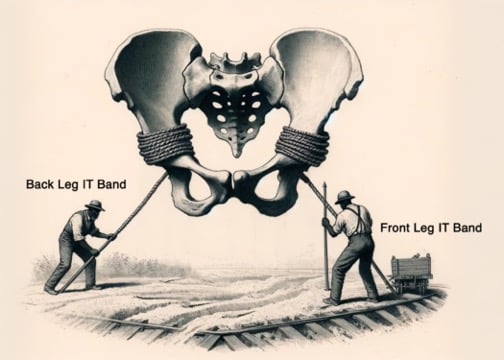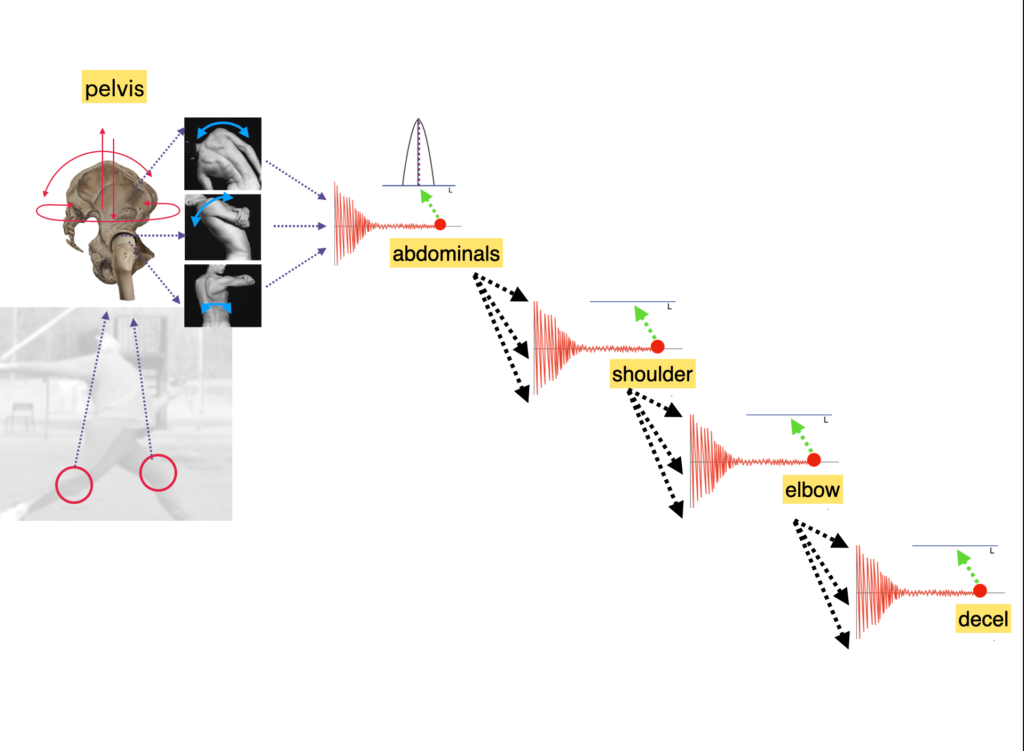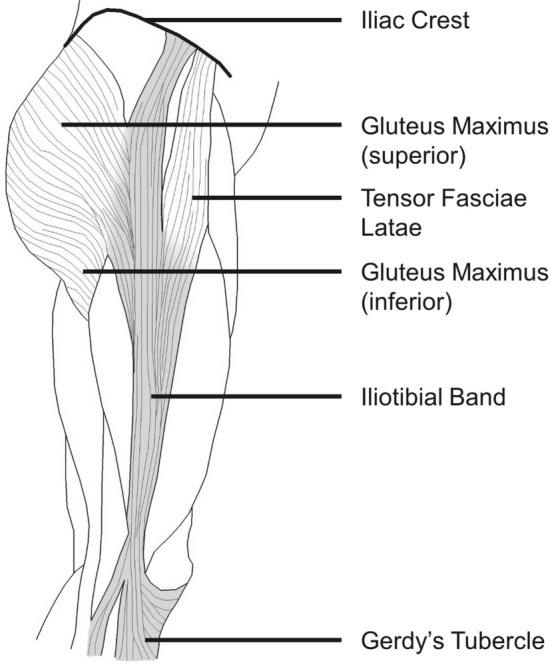
For high level performance and safety in pitching, the pelvis is the center of the universe. Pitching begins as a relatively low-intensity movement primarily involving the lower body and subsequently transitions into a high-intensity phase that heavily engages the  abdominals, shoulder, and elbow. The lower body's contribution at the outset appears modest, which prompts questions about the value of rigorous, heavily loaded leg strength training in training regimens. However, as the pitch advances into its high-intensity phase, encompassing the abdominals, shoulder, elbow, and deceleration, it evolves into a truly remarkable demonstration of motor control, speed, and power, rivaling the finest displays of athleticism across sports.
abdominals, shoulder, and elbow. The lower body's contribution at the outset appears modest, which prompts questions about the value of rigorous, heavily loaded leg strength training in training regimens. However, as the pitch advances into its high-intensity phase, encompassing the abdominals, shoulder, elbow, and deceleration, it evolves into a truly remarkable demonstration of motor control, speed, and power, rivaling the finest displays of athleticism across sports.
This transition from lower body to upper body dominance starts at the pivotal point of the pelvis. Therefore, the precise positioning of the pelvis is of paramount importance, as it serves as the foundational platform from which energy is launched up the kinetic chain.
The iliotibial band (IT Band) plays a vital role in stabilizing the pelvis in transverse plane. The IT Band is a robust, thick, ligament-like tissue that attaches at the hip proximally to fibers of the gluteus maximus (a primary hip extensor) and to the tensor fascia lata muscles (which aids in hip flexion). Interestingly, these two muscles are antagonistic during the act of pitching. Distally the IT band crosses the knee bracing against the lateral femoral condyle and inserting on Gerdy’s Tubercle on the proximolateral tibia.
gluteus maximus (a primary hip extensor) and to the tensor fascia lata muscles (which aids in hip flexion). Interestingly, these two muscles are antagonistic during the act of pitching. Distally the IT band crosses the knee bracing against the lateral femoral condyle and inserting on Gerdy’s Tubercle on the proximolateral tibia.
Researchers have reported that the IT Band can tolerate up to 2000 pounds of tensile force without significantly elongating (1,2). In other words, one could hang a car from the IT band, and it wouldn’t stretch. According to Hutchison et al (3), because of our bipedal nature, humans are the only species that evolution has afforded an IT band. Anatomy happens for a reason. Taking advantage of this unique anatomical feature seems particularly important for performance in high-intensity activities.
The Back Leg IT Band
As a pitcher makes the transition from the loading phase to the extension of the trail hip and knee, a crucial co-contraction between the gluteus maximus and tensor fascia lata comes into  play. This coordinated effort serves to eliminate any slack within the IT Band, essentially transforming it into a robust supporting tension wire. This momentary reinforcement prevents any unwarranted forward rotation of the pelvis in the transverse plane, a pivotal element in the pitching motion. In other athletic contexts like sprinting, this amalgamation of ankle plantar flexion, knee extension, and hip extension is sometimes termed “triple extension.” However, this label, while identifying the joint positions involved, overlooks the equally vital conditions of isometric co-contraction and proximal to distal action. In high-intensity activities demanding precision and agility, this phenomenon has been aptly dubbed “hip lock” by Frans Bosch (4)
play. This coordinated effort serves to eliminate any slack within the IT Band, essentially transforming it into a robust supporting tension wire. This momentary reinforcement prevents any unwarranted forward rotation of the pelvis in the transverse plane, a pivotal element in the pitching motion. In other athletic contexts like sprinting, this amalgamation of ankle plantar flexion, knee extension, and hip extension is sometimes termed “triple extension.” However, this label, while identifying the joint positions involved, overlooks the equally vital conditions of isometric co-contraction and proximal to distal action. In high-intensity activities demanding precision and agility, this phenomenon has been aptly dubbed “hip lock” by Frans Bosch (4)
The IT Band’s Contribution to Separation
The concept of “hip lock” serves a dual purpose in the pitching motion. First, it acts as a safeguard against premature forward rotation of the pelvis, preserving the integrity of the movement. Simultaneously, it initiates a critical process by bringing the abdominals closer to their  optimal length, a factor often associated with “hip to shoulder separation.” The abdominal muscles play a pivotal role in channeling the energy amassed during the load and ride phase up the kinetic chain, ultimately directing it towards the arm. However, due to their anatomical structure, the abdominals have a remarkably narrow sweet spot when it comes to optimal length, earning them the nickname “divas of the system.”
optimal length, a factor often associated with “hip to shoulder separation.” The abdominal muscles play a pivotal role in channeling the energy amassed during the load and ride phase up the kinetic chain, ultimately directing it towards the arm. However, due to their anatomical structure, the abdominals have a remarkably narrow sweet spot when it comes to optimal length, earning them the nickname “divas of the system.”
Any deviations in the positioning or stability of the pelvis can adversely affect the abdominals in their vital function. Consequently, the achievement of “separation” should primarily be a natural byproduct of the hip lock, rather than a result of excessive counter-rotation of the torso. This approach aligns seamlessly with the concept of proximal-to-distal action, a fundamental stability condition that underpins the mechanics of high-intensity activities across the board.
The Front Leg IT Band
The role of the lead leg IT band becomes equally crucial after the front foot lands during the pitching motion. It is essential to recognize that the quality of hip lock and three-plane pelvic control during the load and ride phases significantly influences the dynamics of the lead leg. When the transition from the back hip hinge to hip lock is well-timed, it generates tension that enables the lead leg gluteals and hamstrings to smoothly retract the lead leg toward the rubber as it makes contact with the ground. This highly efficient movement known as “swing-leg-retraction” and “foot plant from above,” encourages the centration of the leading femur within the acetabulum (hip socket), resulting in a slightly bent knee as the front leg lands.
control during the load and ride phases significantly influences the dynamics of the lead leg. When the transition from the back hip hinge to hip lock is well-timed, it generates tension that enables the lead leg gluteals and hamstrings to smoothly retract the lead leg toward the rubber as it makes contact with the ground. This highly efficient movement known as “swing-leg-retraction” and “foot plant from above,” encourages the centration of the leading femur within the acetabulum (hip socket), resulting in a slightly bent knee as the front leg lands.
This alignment is important because it maintains a relatively equivalent angle between the hip and knee, keeping the quads, hamstrings, and glutes near their optimal lengths. In this position, the rigid IT band firmly contacts the lateral femoral condyle. As the pitcher transitions to full weight-bearing, the gluteus maximus and tensor fascia lata co-contract, eliminating any slack in the IT band. Here, the IT band effectively acts as a brace, preventing excessive rotation of the front of the pelvis in the transverse plane. The IT band of the front leg then assumes the role of a secondary tension wire, essentially locking the pelvis in a state of stability, setting the stage for the high-intensity phase and the transfer of energy up the kinetic chain.
Errors in the Back Leg
Since the back leg is primarily active during the low-intensity load and ride phase, a broader spectrum of movement options may be acceptable. It is crucial to maintain proper pelvic control in the frontal, sagittal, and transverse planes. In situations where the pelvis is well-positioned and controlled, perceived “errors” in the back leg might actually offer valuable movement solutions. However, if these back leg errors lead to poor positioning and destabilization of the pelvis, they can indeed become problematic.
One common error occurs when a pitcher overly emphasizes the depth of their load, often stemming from well-intentioned coaching advice to “use their legs more.” In response, the athlete may excessively flex the back knee beyond a point they can effectively manage. This knee flexion, in turn, causes the back knee and center of mass to shift forward, resulting in a quad dominant move that disrupts the athlete's ability to smoothly transition from a hinged hip into a hip lock. Consequently, premature forward rotation of the back hip emerges, infringing upon the optimal length required for the abdominals to efficiently transport energy.
Errors in the Lead Leg
A poorly timed or executed back hip lock can disrupt the tension required for the desired swing leg retraction in the lead leg. When this occurs, the lead leg tends to slide into landing, compelling the athlete to resort to sudden and forceful co-contraction of the muscles around the lead hip and knee to prevent excessive forward rotation of the front of the pelvis. The pitcher faces the challenging task of maintaining relatively equivalent states of flexion in both the knee and hip, and they must apply forceful internal rotation to the lead hip to prevent the front knee from passively extending or deviating to the side. Both of these undesired outcomes would introduce slack into the IT band. It's crucial to emphasize that executing this maneuver demands impeccable timing and consumes more energy compared to when the lead leg retracts and the front foot lands from above.
In situations where the front knee passively extends too early, as seen in the commonly practiced “lead leg block,” the IT band tends to slide forward of the femoral condyle, causing the tension wire to slacken. Similarly, if the pitcher allows their front knee to leak forward or veer too far to the side, the tension wire also slackens, and the athlete struggles to prevent excessive pelvic rotation in the transverse plane.
Optimizing IT Band Stiffness in Training
Recognizing the under appreciated significance of the IT Bands in stabilizing the pelvis within the transverse plane serves as a foundational element in crafting effective pitcher training regimens. Coaches should create a training environment that subjects both hips and the abdominal region to pre-tension, time pressure, and unpredictable loads. Within this context, athletes can organically develop the ability to instinctively engage the necessary co-contractions to eliminate any slack within the IT Bands. This process ultimately establishes the solid foundation of pelvic stability, which acts as the linchpin for achieving peak performance and ensuring safety in pitching.
that subjects both hips and the abdominal region to pre-tension, time pressure, and unpredictable loads. Within this context, athletes can organically develop the ability to instinctively engage the necessary co-contractions to eliminate any slack within the IT Bands. This process ultimately establishes the solid foundation of pelvic stability, which acts as the linchpin for achieving peak performance and ensuring safety in pitching.
If you’re interested in learning more about optimizing your anatomy and using leading edge movement science to develop the tools you need to attract the attention of college recruiters and pro scouts check out one of the four ways to engage our services:
Extended Stay SAVAGE Winter Training Weekend SAVAGE Boot Camp
Precision Strike One-on-One Session SAVAGE Satellite Training
If you’d rather speak to us in person, call any time: 866-787-4533.
Let's Get SAVAGE!
References:
- Seeber GH, Wilhelm MP, Sizer PS Jr, Guthikonda A, Matthijs A, Matthijs OC, Lazovic D, Brismée JM, Gilbert KK. The Tensile Behaviors of the Iliotibial Band – A Cadaveric Investigation. Int J Sports Phys Ther. 2020 May;15(3):451-459.
- Chaudhry H, Schleip R, Ji Z, Bukiet B, Maney M, Findley T. Three-dimensional mathematical model for deformation of human fasciae in manual therapy. J Am Osteopath Assoc. 2008 Aug;108(8):379-90.
- Hutchinson LA, Lichtwark GA, Willy RW, Kelly LA. The Iliotibial Band: A Complex Structure with Versatile Functions. Sports Med. 2022 May;52(5):995-1008.
- Bosch, F. (2020). Anatomy of Agility. Rotterdam, The Netherlands 2010 Publishers

Randy Sullivan, MPT, CSCS CEO, Florida Baseball ARMory




